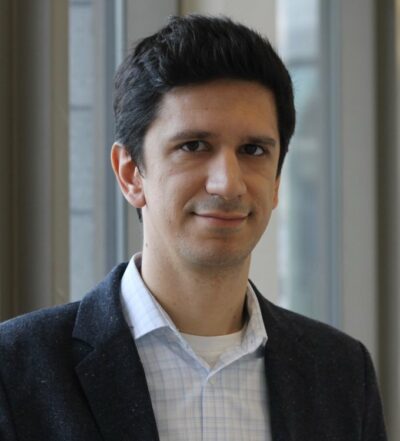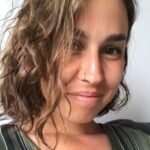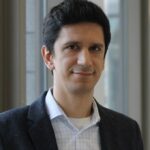“What a wonderful stimulant it would be for the beginner if his instructor, instead of amazing and dismaying him with the sublimity of great past achievements, would reveal instead the origin of each scientific discovery, the series of errors and missteps that preceded it— information that, from a human perspective, is essential to an accurate explanation of the discovery. Skillful pedagogical tactics such as this would instill the conviction that the discoverer, along with being an illustrious person of great talent and resolve, was in the final analysis a human being just like everyone else.” ― Santiago Ramón y Cajal, Advice for a Young Investigator
The second annual Rising Star in Bio-imaging in Quebec was awarded to Dr. Bratislav Misic, Assistant Professor in the Department of Neurology and Neurosurgery at McGill University. Dr. Misic leads the Network Neuroscience lab at the Montreal Neurological Institute, where he and his team investigate how brain networks — the interactions between brain regions — support complex behaviour. We sat down with Dr. Misic for a chat to learn more about him and his research trajectory, and were struck by his humility and positivity. It was a breath of fresh air during these trying times. We hope our interview with Dr. Misic serves as a source of inspiration and wisdom for you, as much as it did for us.
You can catch Dr. Misic’s keynote lecture entitled The Connected Brain at the QBIN Virtual Scientific Days 2021 on March 9!
Who is Bratislav Misic?
I was born in Belgrade, Serbia. We lived there until I was 11. Because of the war, my family and I moved to Hong Kong, where we stayed for seven years. We then immigrated to Canada. We travelled around a lot, but once we got to Canada I felt very settled. I did my undergraduate studies at the University of Toronto in Neuroscience and Mathematics. I did my PhD with Randy [McIntosh] and I have been in this field ever since. My PhD was a great and formative experience. Half way through my PhD, I also had the opportunity to visit Olaf Sporns, a close collaborator of Randy, with whom I then did my postdoc at Indiana University in Bloomington, for a couple of years.
What inspired you to become a scientist and pursue Network Neuroscience?
I love science and learning, specifically Network Neuroscience and this idea of complex systems more generally. In a seemingly disorganized, complex set of elements you can actually make predictions about the importance of a single element and the capacity of the whole system to function based on how all elements are connected together. When I realized that this was the way people conceptualized the brain, that was the way I wanted to go.
How would you describe your research trajectory so far?
In a nutshell, it has been looking at the interactions between brain areas and how they support the emergence of global dynamics, cognitive operations and complex behaviour.
We divide our work in theoretical questions (e.g., how does the architecture of the brain support function?) and in empirical questions (e.g., if we know something about the wiring patterns of a group of people, can we make predictions about how they will perform certain tasks, and how likely they are to develop a particular disease).
Who are your mentors and what do you most appreciate about your mentorship relationships?
My two mentors are Randy McIntosh and Olaf Sporns. Both are really fantastic scientists, but also very kind and supportive. I wouldn’t move an inch in my career without them.
Randy really set the stage. In his lab, every trainee would pick the project they wanted to do and they really had the freedom to explore the questions they were interested in. This allowed me, from early on, to figure out what it is that I wanted to do. With Olaf, it was very much the same. He runs a focused group but one where you can really explore in depth questions like “How is the brain organized?”.They have a slightly different approach to mentorship and project management but at the end of the day, the core philosophy is the same: do the best you can to attack the questions you are most interested in.
Another important figure that has helped me a lot in my transition from being a postdoc to becoming a faculty member (I was a postdoc for two years) is Alain Dagher. He is right next door to me at the MNI so anytime I have a question, or a good enough idea for a grant, I can just go to him. Alain has helped me a lot to build my group here in Montréal. But there are many other individuals I have met along the way that have helped me and my research. At the MNI, for instance, we have a very supportive set of faculty.
This is such a positive description of academia, which is great! We all need to hear this.
This has been my experience! Science is always a collaborative process. The one aspect I realized is important to run a good lab is to have individuals willing to help each other and enjoy helping each other. What I don’t like to see is when I go into the lab and everyone is laser-focused, with their headphones on. I much prefer seeing my students arguing about something, asking each other “Does anyone really understand this?”, and interacting with each other.
What type of research leader are you?
I personally have no natural authority. A good graduate experience is not just a good student or a good mentor or a good project idea, you need all three. You can have the most talented student in the world and the most talented PI, but if they don’t mesh well, it just won’t work. Our approach is to come up with research questions in an organic way: an idea that I am interested in but also my trainees are interested in. We try not to limit ourselves to a specific set of hypotheses. We give ourselves the freedom to explore and don’t shy away from topics that are new to us, something that I learned from Randy. In our lab, our bread and butter is MRI but we work with a lot of other neuroimaging modalities, such as PET, MEG, EEG, but also with gene expression, neuroreceptor data. In doing so, we keep an open mind and a collaborative spirit.
What excites you most about your research?
We’re just scratching at the surface of this idea that we can represent the brain as a network and the collective function of this network can be more than the sum of its parts. Over the past 10 to 15 years, this has been an idea that has become popular and people have come up with lots of different ways to quantify the architecture of the brain, and to understand how signaling might take place in this network and how we can make statistical inferences about the relationship between brain networks and behaviour.
What I think is really neat going forward is two directions: one, we’ve been pretending for a very long time now that all the nodes in our networks are the same because this is a convenient way to represent the brain, but really they are not. They vary drastically in terms of their cytoarchitecture, gene expression, receptor profiles, intrinsic dynamics, in terms of oscillatory activity, myelination. All of these properties are things that we routinely measure in garden-variety MRI protocols but also have access through other sources and so this idea that we can actually annotate our networks and incorporate a lot of these biological attributes into our graph models so we can ask: what is the relationship between local properties and global connectivity? I think this is a super exciting question and feeds directly into our primary question: what is the relationship between structure and function? This is in many ways the most fundamental question in many natural sciences and natural occurring systems and man-made systems, so that’s what we’re trying to address. We’re beginning to have the data and also have the theoretical framework for addressing questions like that.
The other direction that we’re moving more towards is this idea that we’ve quantified and described a lot of the static properties of networks. We’ve related network architectures statistically to individual differences in behaviour. What we really don’t know is how computations actually emerge in brain networks. In my lab, we are thinking of these connectomes we’re generating from different neuroimaging modalities, such as diffusion imaging and tract tracing, and implementing them as artificial neural networks and training them to do real world tasks. What we can really say then is, “I think there’s a property of the brain that’s exciting, say the brain has hubs or specialized modules: what is the actual consequence of that feature on the ability of the brain to remember temporal sequences? Or to navigate space?”
What’s really driving our research and what inspires our imagination is the fact that there are all these simultaneous technological advances and interesting properties about the brain that we can now measure. There are all of these initiatives for data sharing, standardization, open science where people like me, who run a computational lab, have access to these resources and can incorporate datasets (features of the brain) into our existing models and existing ideas of how the brain works and generate new hypotheses. Things like big datasets about various clinical populations are right at our fingertips. It’s a super exciting time to be in this field because neuroimaging is rapidly becoming the focal point for interdisciplinary science.
What have you been learning from doing interdisciplinary research and how do you digest the host of information that comes with it?
I start out being clear in my mind that there’s definitely things I don’t know. We have to be very humble and make the assumption that there are things we don’t know. The first thing we do when we open a new front and try something we really haven’t done before is to get a great collaborator. Having great students is one part of the equation and having a great collaborator and being honest about where you stand is another. That’s what I tell my students all the time. We start doing something and they get to the point where now this is the limit of our knowledge of the topic. We need to bring someone else who could tell us if we’re on the right path, and that’s why our papers have quite a few experts at the MNI, McGill and around the world. It’s important to always have good people as your sounding board. That is true of any kind of endeavor you take in science. Sanity checks are always important.
Also be prepared to go through a learning curve, for there will be some growing pains. But also get help as soon as you can and don’t be afraid to ask for help. I have no shame in emailing people I know very well or people I’ve been friends with at conferences and people I’ve never met but from Twitter, they seem to know what they’re doing. I’m constantly pinging people for questions or snippets of scripts.
How do you approach failure in science and what’s your game plan after failure?
There’s no such thing as failure. If you think about charting a path through a very complex, not completely known landscape, you get to a point and you realize you can’t go any further, that tells you something for your path down the line. There can be days when things aren’t working out and those days seem like a failure. It’s easy to say but very hard to actually put into practice when it’s happening to you: it’s to take a step back and see the bigger perspective, and to understand that you might be having trouble now but it will work itself out. You have to keep attacking the problem and keep thinking of new ways and posing the question in different ways, but the answer will come. It’s like in Seinfeld, the episode where Jerry says “things always even out for me”.
The other thing is that the lifetime of a project is extremely non-linear. A project or an idea can take a huge amount of gestation initially and then the main result that ends up being in your paper could be an afternoon’s worth of work. The 10 bad days were the subconscious marinating period that allowed that one good day to happen.
In a more practical way, we try not to give up on things. Sometimes we give up on things because it was a strategic error, but we learn something from it. Otherwise, I think there’s value in communicating to other scientists what you found, regardless of whether that really gives the answer you wanted or the hot answer that would get you the fancy publication. Maybe not too many people may be interested in this now but hopefully someone comes to your work and they decide to take a path because of what they read from your work.
What you mentioned about failure as a time to stop and think whether or not you’re seeing a question the right way, asking the right question. It’s an opportunity to pause and reflect on your own approach. That’s a great way to think about it!
That’s a good point you bring up because when something isn’t working, you have to ask yourself exactly that, which is: did I pick the wrong method? If I picked the wrong method, then I go in a different direction. However, if I still believe that the question is interesting even though right now the experiment isn’t working, then let’s keep going. We figure out a new method. Methods are disposable but the questions are really what drives progress, and what makes a paper worth reading — if someone posed the right question.
That’s the other thing I try to impart on students: we need to ask the kind of questions where no matter what answer you get, it’s interesting. You don’t want to have an experiment where you have to run 100 participants on a task that’s difficult to do and the only way you’re happy is if you get a significant difference in a particular direction. That’s going to drive you crazy!
Did you learn something about yourself or about how you conduct research during this pandemic that you think you’ll take forward with you in a non-pandemic world?
For sure. The pandemic obviously is a terrible time for people who are getting sick, losing their lives and livelihoods. Even in academia, there are people who are not able to continue with their research. We’re fortunate because we’re a computational lab so we’re not affected in a major way. It has brought into focus something that I really enjoy which is to sit and outline papers and work on figures and scripts together with the students. Sharing the screen and being able to ping someone real quick to try something together, that has been great.
I very much try to maintain a small group: our lab has never had more than five people and that’s for this purpose of maintaining good cohesion. It’s forced us to come up with new and interesting formats for lab meetings that I really have enjoyed. Some of which I’ve seen on Twitter, others I literally invent, and some are suggestions by students. We do journal clubs like everyone else, but we also do internal journal clubs. When we have a paper ready in the lab which doesn’t necessarily involve everyone, we give it around to read and tear apart and do a journal club based just on that. That’s probably my favourite thing to do in the lab because everyone in the lab is the biggest expert on a specific topic so if we can get it past everyone in the lab, then I’m confident it will work with readers and reviewers.
The pandemic experience has forced us to reconsider what we do and how we interact with one another but also streamlining how we do projects. That’s the kind of thing that I’ll take with me, but I can’t wait to get back into the lab!
What is your typical schedule like on a daily basis? Well, now with your newborn, I assume it is a tad different!
With the kid, it is a bit touch and go. My wife is also in academia and just got a faculty position. My day is mostly Zoom meetings with students. The nice thing about the lockdown is that I was able to really focus on my students, which has been wonderful and rewarding.
I wake up, eat breakfast, hop on Zoom. I have a 3-hour schedule now that I am on paternity leave, to talk to students. And then I attend to my parenting duties but I still stay on Slack and make sure I am available to answer questions, as things come up.
On weekends I do a lot of reviewing and I try to catch up on things that I missed during the week.
What’s your approach to work-life balance?
I think of research more in terms of a calling or vocation. The beautiful thing about academia is that you can set your own time. I really think that work and time away from work help each other out. When you are overly focused on work and you are tiring yourself out, taking a step back to hang out with your loved ones, cook, take a walk, makes you appreciate your life more. And when you do so, that time away from the keyboard can help you be better at work. I think there’s no coincidence that both Novak Djokovic and Roger Federer became better once they had their kids. We went on lockdown and I had a kid, but the past nine months have been the most productive time for the lab.
What are your interests and hobbies outside of research?
I have an interest in film. I spend a lot of time on Kanopy and the Criterion Channel. I read a lot about old Hollywood movies and I watch a lot of black and white movies. I used to follow sports before I became a principal investigator and had a kid but I am actually in a fantasy football league with a bunch of people at the Neuro. Nowadays, most of my time is spent hanging out with the baby. It’s a weird time to take up running but I did take up running in the winter [standing ovation from the interviewers]. I enjoy it: the first 5-10 minutes you think you made a huge mistake but after a while you will be ok.
What’s something about you that most people don’t know?
I spend an enormous amount of time on Reddit. And literally everyone in my family is a scientist: my parents are professors in computer science in Toronto, my brother is a professor of engineering at UCLA and my wife is now a professor in biology at Concordia.
Finally, what does it mean to you to receive the QBIN Rising Star Award?
It’s extremely flattering! QBIN is an important organization for our science in Québec and it encompasses a broad network of researchers so I feel very flattered and fortunate. Just in Montréal, we have such a strong group of researchers and Québec more generally, so I feel very fortunate. I think this is hopefully an award for the work we’ve done and, in that sense, it’s an award for the students that have done this work and our collaborators and the mentors I’ve had along the way because these are all the people on these papers. I couldn’t help but notice that the person who got it before me was Max Descoteaux so to get the same award is extremely flattering. I’m not sure I’m in that category but I feel very fortunate.
We’re going to ask a few quick fire questions so you have to respond as quickly as possible.
MNI or Neuro?
MNI
MATLAB or Python?
MATLAB
Open Data or Collecting Data?
Open data
Resting state or task-fmri?
Resting
Introvert or Extrovert?
Introvert
Summer or winter?
Winter
Montreal bagels or poutine?
Bagels
Beach or mountains?
Mountains
Rock or classical music?
Rock
We couldn’t let you go without this last one…testing your Serbian origins: Federer or Djokovic?
Djokovic c’mon! No question!
Thank you so much for taking the time to chat with us! This has been really fun and we’ve learned so much.




